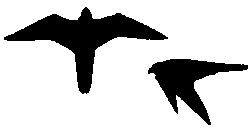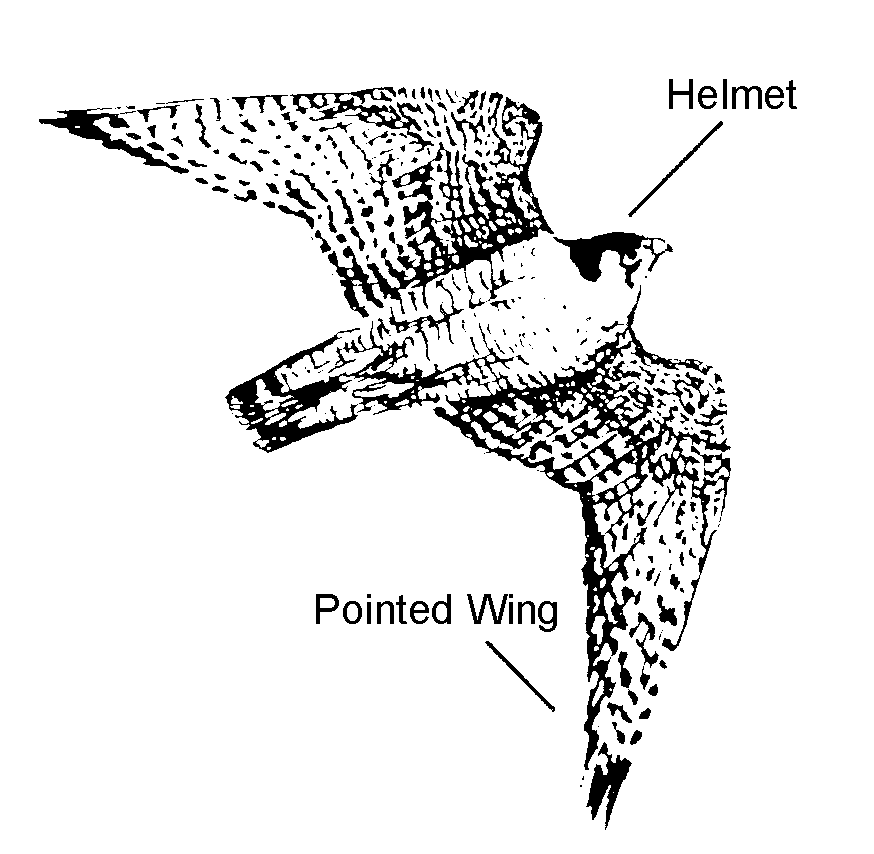

The Canadian Peregrine Foundation
NEWS & NOTES |
ARTICLE 3 - Watching for Nesting
Peregrines - the 2000 Peregrine Falcon Survey
(by Ted Armstrong, Ministry of Natural Resources)
Wednesday April 19, 2000
The American, or anatum¸ peregrine falcon was one of the
first species designated under Ontario’s new Endangered Species Act in 1977.
Peregrines disappeared as a breeding species from Ontario and most of southern Canada in
the early 1960s as a result of DDT contamination. A National Recovery Team was put in
place, and a National Recovery Plan was developed to assist with the re-establishment and
recovery of this endangered species. Recovery efforts have been underway across Canada,
including Ontario, for over 20 years. This has included the release of over 500
captive-reared peregrines at hacking sites in both northern and southern Ontario since the
late 1970’s. While the status of peregrines has been upgraded from endangered to
threatened nationally, in Ontario the peregrine falcon is still considered an endangered
species. The peregrine falcon first began nesting again in the province in the mid-1980s,
and since then the population has shown gradually improving signs of recovery annually. In
1999, there were over 30 occupied nesting territories in Ontario, including 23 confirmed
territorial pairs and 21 confirmed nesting attempts, from which over 50 young fledged.
Ontario takes part in the national peregrine survey that is conducted every 5 years. Results from this survey present a national picture of the status of the peregrine falcon across the country. The next national survey is occurring in 2000. The objective of this survey is to locate and monitor all peregrine falcon nesting activity throughout the province. The results of the 2000 survey will be very important in helping to assess the appropriate status for this species in Ontario.
In northern Ontario, peregrine falcons nest on high, steep cliffs, often overlooking large bodies of water. These cliffs are usually, but not always, in remote undisturbed situations. In southern Ontario, some peregrines have established territories in urban centres, and are nesting on tall buildings. Wildlife observers are asked to watch for and report any signs of nesting activity by peregrine falcons during the March-August nesting period, including signs of an occupied territory, a territorial pair or a confirmed nesting attempt, and information on the number of young fledged.
The goal of the 2000 survey is to locate and monitor all peregrine falcon nesting activity in Ontario in 2000. To achieve this goal, the support and cooperation of birders, hikers, naturalists, fishermen, canoeists, and other outdoor recreationists is requested. If you observe possible peregrine falcon nesting activity during the nesting season, please contact your local Ministry of Natural Resources office or participating naturalist organization. Reports for nests that are already being monitored and reported on by the Canadian Peregrine Foundation should continue to be directed to the CPF. The most important observation details include:
Information may also be submitted directly to:
Project Peregrine
Ontario Ministry of Natural Resources, Northwest Region
435 James Street South, Suite 221
Thunder Bay ON P7E 6S8
Tel: 807-475-1127
Fax: 807-473-3023
E-mail: ted.armstrong@mnr.gov.on.ca
Identifying a Peregrine - The peregrine falcon is a fast-flying, crow-sized raptor with long, pointed wings, a long narrow tail, quick, powerful wingbeats, and a distinctive facial pattern with heavy dark "sideburns". Adults are a dark slate-gray colour on the back, with a light-coloured barred breast, while younger birds are brown with a heavily streaked breast. They can often be identified by their distinctive call, which is a repeated "kek-kek-kek-kek".
|
|
For more information on the 2000 peregrine falcon survey:
| Ted Armstrong Ontario Ministry of Natural Resources Thunder Bay Tel: 807-475-1127 E-mail: ted.armstrong@mnr.gov.on.ca |
Brian Ratcliff Project Peregrine Thunder Bay Field Naturalists Tel: 807-768-8408 E-mail: brat@norlink.net |
The Ministry of Natural Resources is collecting comments and information regarding the peregrine falcon survey under the authority of the Endangered Species Act. Comments will become part of the public record and will be used to help make management decisions for the peregrine falcon. Under the Freedom of Information and Protection of Privacy Act, personal information will remain confidential unless prior consent is obtained. This information may be used by the Ministry of Natural Resources to seek public input on similar natural resource management surveys and projects. For more information about the Freedom of Information and Protection of Privacy Act, please contact Dave Jackson at (807) 475-1581.
RETURN TO COMPLETE SITE INDEX
(or choose from selected popular links below)
CPF INFORMATION:
| Home | News
| Talon Tales | Search
|
| Membership |
| About CPF | CPF Projects |
Project Track-'em | Education Program |
BIRD INFORMATION:
| Webcams | Photo Galleries |
Sightings | Identification
Tips |
| Peregrine information | Owls
| Other Raptors |
Links |
© Canadian Peregrine Foundation